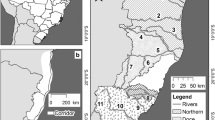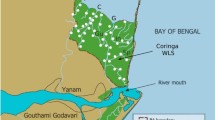Abstract
We found a total of 987 prey in the 500 scats of feral catsFelis silvestris catus Linnaeus, 1758 analyzed in the present study. Introduced mammals (rabbits, rats and mice) constituted the most important prey both in percentage and biomass. Reptiles were the second most important prey, being more frequent than birds and invertebrates. Mammals were the most frequently eaten group in all five main habitats of the island, being more frequent than the remainder of prey in the laurel forest. Rabbits appeared more often in the temperate forest, rats in the laurel forest and mice in the high mountain. Birds were more frequently captured in the three higher habitats (laurel and pine forest, and high mountain) than in the two lower ones (xerophytic shrub and temperate forest). Reptiles were preyed on less in the laurel forest than in the other main habitats. Morisita index indicates a high trophic overlap among the different habitats with the exception of the laurel forest which shows important differences from the other habitats. Levin’s niche-breadth was broader in the xerophytic shrub and narrower in the temperate forest, reaching intermediate levels in the other three main habitats. The results obtained in the present study evidence a general pattern in the trophic ecology among similar habitats in the different subtropical Canarian islands. However, some important differences exist that could be a function of the differential prey availability and composition in each ecosystem.
Similar content being viewed by others
References
Afonso L. 1985. La Palma. [In: Geografía de Canarias IV. L. Afonso, ed]. Editorial Interinsular Canaria, Santa Cruz de Tenerife: 10–94.
Andersson M. and Erlinge S. 1977. Influence of prédation of rodent populations. Oikos 29: 591–597.
Atkinson I. A. E. 2001. Introduced mammals and models for restoration. Biological Conservation 99: 81–96.
Cabrera-Rodriguez F. 1997. Variaciones de la abundancia del conejo (Oryctolagus cuniculus Linneo, 1758) en La Palma, islas Canarias (Lagomorpha, Leporidae). Vieraea 26: 133–137.
Courchamp F., Langlais M. and Sugihara G. 2000. Rabbits killing birds: modelling the hyperpredation process. Journal of Animal Ecology 69: 154–164.
Courchamp F., Chapuis J. L. and Pascal M. 2003. Mammal invaders on islands: impact, control and control impact. Biological Reviews 78: 347–383.
del Arco M., Acebes J. R., Pérez de Paz P. L. and Marrero M. C. 1999. Bioclimatology and climatophilus vegetation of Hierro (part 2) and La Palma (Canary Islands). Phytocoenologia 29: 253–290.
Delibes M. 1980. esEl lince ibérico: ecología y comportamiento alimenticio en el Coto Doñana, Huelva. Doñana Acta Vertebrata 7: 9–128.
Dilks P. J. 1979. Observations on the food of feral cats on Campbell Island. New Zealand Journal of Ecology 2: 64–66.
Fitzgerald B. M. 1988. Diet of domestic cats and their impact on prey populations. [In: The domestic cat: the biology of its behaviour. D. C. Turner and P. Bateson, eds]. Cambridge University Press, Cambridge: 123–147.
Fitzgerald B. M. and Karl B. J. 1979. Foods of feral house cats (Felis catus L.) in forest of the Orongorongo Valley, Wellington. New Zealand Journal of Zoology 6: 107–126.
Fitzgerald B. M. and Veitch C. R. 1985. The cats of Herekopare Island, New Zealand; their history, ecology and effects on birdlife. New Zealand Journal of Zoology 12: 319–330.
Fitzgerald B. M. and Turner B. M. 2000. Hunting behaviour of domestic cats and their impact on prey populations. Second edition. [In: The domestic cat: the biology of its behaviour. D. C. Turner and P. Bateson, eds]. Cambridge University Press, Cambridge: 151–175.
García R., Ortega G. and Pérez-Sánchez J. M. 1992. Insectos de Canarias. Ediciones del Cabildo Insular de Gran Canaria, Las Palmas de Gran Canaria: 1–418.
García-Márquez M., Caetano A., Bello I., López-Jurado L. F. and Mateo J. A. 1999. Ecología del gato cimarrón en el ecosistema termófilo de El Hierro (Isias Canarias) y su impacto sobre el lagarto gigante (Gallotia simonyi). Monografía Herpetológica 4:207–2222.
Groombridge B. and Jenkins M. D. 2000. Global biodiversity: earth’s living resources in the 21st century. United Nations Environmental Programme, World Conservation Monitoring Centre & World Conservation Press, Cambridge: 1–256.
Gorman M. L. 1979. Island ecology. Chapman and Hall, London: 1–78.
Izquierdo I., Martín J. L., Zurita N. and Arechavaleta M. (eds) 2001. Lista de especies silvestres de Canarias (hongos, plantas y animales terrestres) 2001. Consejería de Política Territorial y Medio Ambiente, Gobierno de Canarias, Santa Cruz de Tenerife: 1–437.
Jones E. 1977. Ecology of the feral cat,Felis catus (L.), (Carnivora: Felidae) on Macquarie Island. Australian Wildlife Research 4: 249–262.
Karl B. J. and Best H. A. 1982. Feral cats on Stewart Island; their foods, and their effects on Kakapo. New Zealand Journal of Zoology 9: 287–294.
Kirkpatrick R. D. and Rauzon M. J. 1986. Foods of feral catsFelis catus on Jarvis and Howland Islands, Central Pacific Ocean. Biotropica 18: 72–75.
Konecny M. J. 1987. Food habits and energetics of feral house cats in the Galapagos Islands. Oikos 50: 24–32.
Krebs C. J. 1989. Ecological methodology. Harper Collins, New York: 1–654.
Laurie A. 1983. Marine iguanas in Galapagos. Oryx 17: 18–25.
Mac Arthur R. H. and Wilson E. O. 1967. The theory of island biogeography. Princeton University Press, Princeton: 1–203.
Marshall W. H. 1961. A note on the food habits of feral cats on Little Barrier Island, New Zealand. New Zealand Journal of Science 4: 822–824.
Marzol-Jaén M. V. 1984. El Clima de Canarias. [In: Geografía de Canarias I. L. Afonso, ed]. Editorial Interinsular Canaria, Santa Cruz de Tenerife: 157–202.
McNeely J. A., Mooney H. A., Neville L. E., Shei P. and Waage J. K. (eds) 2001. A global strategy on invasive alien species. World Conservation Union, Gland: 1–50.
Medina F. M. and Nogales M. 1993. esDieta del gato cimarrón (Felis catus L.) en el piso basal del Macizo de Teno (Noroeste de Tenerife). Doñana Acta Vertebrata 20: 291–297.
Nogales M., Martín A., Delgado G. and Emmerson K. 1988. Food spectrum of the feral cat (Felis catus L., 1758) in the juniper woodland on El Hierro (Canary Islands). Bonner zoologische Beiträge 39: 1–6.
Nogales M., Abdola M., Alonso C. and Quilis V. 1990. Premèires données sur l’alimentation du chat haret (Felis catus L., 1758) du Parc National du Teide. Ténérife (Iles Canaries). Mammalia 54: 189–196.
Nogales M., Rodríguez J. L., Delgado G., Quilis V. and Trujillo O. 1992. The diet of feral cats (Felis catus) on Alegranza Island (North of Lanzarote. Canary Islands). Folia Zoologica 41: 209–212.
Nogales M. and Medina F. M. 1996. A review of the diet of feral domestic cats (Felis silvestris f.catus) on the Canary Islands, with new data from the laurel forest of La Gomera. Zeitschrift für Säugetierkunde 61: 1–6.
Nogales M., Medina, F. M. and Valido A. 1996. Indirect seed dispersal by the feral catsFelis catus in island ecosystems (Canary Islands). Ecography 19: 3–6.
Nogales M., Martin A., Tershie B. R., Donlan C. J., Veitch D., Puerta N., Wood B. and Alonso J. 2004. A review of feral cat eradication on islands. Conservation Biology 18: 1–10.
Oromí P. 1982. Los tenebriónidos de las Isias Canarias. Instituto de Estudios Canarios 1: 265–299.
Pascal M. 1980. Structure et dynamique de la population de chats harets de l’archipel des Kerguelen. Mammalia 44: 161–182.
Pearre S. Jr and Maass R. 1998. Trends in the prey size-based trophic niches of feral and house catsFelis catus L. Mammal Review 28: 125–139.
Pérez de Paz P. L., del Arco-AguilarM. J., Rodríguez-Delgado O., Acebes-Ginovés J. R., Marrero-Gómez M. V. and Wildpret de la Torre W. 1994. Atlas cartográfico de los pinares canarios III. La Palma. Vice consejería de Medio Ambiente, Gobierno de Canarias, Santa Cruz de Tenerife: 1–160.
Rauzon M. J. 1985. Feral cats on Jarvis Island: Their effects and their eradication. Atoll Research Bulletin 282: 1–32.
Rice W. R. 1989. Analyzing tables of statistical tests. Evolution 43: 223–225.
Santana F., Martín A. and Nogales M. 1986. Datos sobre la alimentación del gato cimarrón (Felis catus Linnaeus, 1758) en los montes de Pajonales, Ojeda e Inagua (Gran Canaria). Vieraea 16: 113–117.
Santos A. 1983. Flora y vegetación de La Palma. Editorial Interinsular Canaria, Santa Cruz de Tenerife: 1–348.
Stone P. A., Snell H. L. and Snell H. M. 1994. Behavioral diversity as biological diversity: introduced cats and lava lizard wariness. Conservation Biology 8: 569–573.
Tranchant Y., Vidal E. and Kayser Y. 2003. Premičres données sur le régime alimentaire du chat haretFelis catus en situation micro-insulaire Méditerranéenne. Revue Écologique (Terre et Vie): 58: 411–418.
van Aarde R. J. 1980. The diet and feeding behaviour of feral cats,Felis catus at Marion Island. South African Journal of Wildlife Research 10: 123–128.
Veitch C. R. 1985. Methods of eradicating feral cats from offshore island in New Zealand. [In: Conservation of island birds. P. J. Moors, ed]. International Council for Bird Preservation, Technical publications no. 3, Cambridge: pp125–141.
Whittaker R. J. 1998. Island biogeography: ecology, evolution and conservation. Oxford University Press, Oxford: 1–285.
Author information
Authors and Affiliations
Additional information
Associate Editor was Krzysztof Schmidt.
Rights and permissions
About this article
Cite this article
Medina, F.M., García, R. & Nogales, M. Feeding ecology of feral cats on a heterogeneous subtropical oceanic island (La Palma, Canarian Archipelago). Acta Theriol 51, 75–83 (2006). https://doi.org/10.1007/BF03192658
Received:
Accepted:
Issue Date:
DOI: https://doi.org/10.1007/BF03192658




